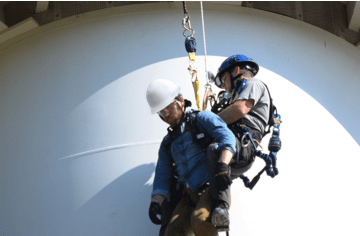
Working at height is dangerous, but sometimes necessary. Fortunately, there are many measures a company can take to protect workers from the risks involved, such as permanent fall protection.
When choosing the right mix of measures, the good old hierarchy of controls is indispensable.
In this blog you can read what this hierarchy means when you are working at height.
What is the hierarchy of controls?
There are various measures to reduce the risk of accidents at work. Some measures are more effective than others. Measures can thus be ranked according to how effective they are in reducing or preventing danger. This is called the hierarchy of controls of measures.
6 levels of prevention
The elimination of danger is the top priority, followed by the replacement of, for example, unsafe tools with safer ones.
Collective protective measures and personal protective equipment are in 3rd and 4th place in the hierarchy.
There are also administrative controls that limit damage, such as a fire extinguisher or an evacuation plan.
At the bottom of the hierarchy of controls is signage to indicate risks with signs and similar.

Why is hierarchy of controls important?
Eliminating danger altogether is obviously the best and most effective measure, but is not always possible. You then have to look at the other levels. The hierarchy of controls helps you determine the mix of measures that is required in your company. On this basis, you can make or amend your company's prevention policy.
But beware: you must include measures from each level in your prevention policy. Even if some measures are less effective than others, they are usually indispensable.
Working at height and hierarchy of controls
Working at height - i.e. a height of over 2 metres - is sometimes unavoidable, but not without danger. Just think of maintenance work on a roof or cleaning a silo. A worker may fall or bump himself during a partial fall. Objects can also fall from above.
That is why preventive measures are of vital importance when working at height.
- Elimination
- Substitution
- Collective protective measures
- Personal protective equipment
- Administrative controls/damage limiting controls
- Signage
1. Elimination of danger

The first preventive measure is to remove the danger. In the case of working at height, this means checking if the work can be done on the ground. This could include operating a machine from the ground, for example. Can the windows be washed from the inside? This is also a form of elimination.
Drones are also increasingly used to carry out inspections on roofs.
2. Substituting the hazard

Replacing the danger of working at height can sometimes be achieved by using scaffolding or an aerial work platform, for example. This is by no means always possible, however, as some places then become inaccessible.
You should also check that the scaffolding or aerial work platform has been inspected and that there are trained staff who can use it. Even with an aerial work platform, you must use a fall harness and a lifeline.
You should also limit the use of ladders as much as possible.
3. Collective protective measures

Examples of collective protective equipment when working at heights include solid handrails to prevent falls or safety nets to catch a fall. These are vital, particularly in companies where employees regularly work at heights. The roofs on industrial estates are increasingly being equipped with railings. This solution is more expensive, but you then need very little training to work on the roof.
More information about our fall protection solutions.
4. Personal protective equipment (PPE)

In addition to collective protective equipment, companies must also provide the appropriate personal protective equipment. This could include a fall arrest harness, a lifeline and a climbing helmet for the employee working at height. To secure fall harnesses, you can equip roofs with permanent solutions such as cable systems or anchor points.
5. Damage limitation measures
Even though measures that limit damage after an accident are near the bottom of the hierarchy of controls, they remain important. Because if someone falls, first aid resources such as a stretcher, bandages or a neck collar will help to limit injuries. There must also be workers present who are trained to give first aid after a fall.
You should also have an evacuation plan, which includes how to get someone downstairs as quickly as possible. This limits the risk of harness suspension trauma.
6. Signage
Clear and unambiguous signs can prevent accidents when working at height. For example zone marking for fall hazards, indicated with black/yellow or red/white stripes. Signs showing which personal protective equipment a worker or visitor should wear, such as fall protection or a helmet, are also very important.
Fixed fall protection on your site
Would you like to know more about working safely at height with permanent and mobile fall protection solutions? Then be sure to download our white paper.
Would you like to purchase fall protection or make sure that everything concerning anchor points and fall protection is in order in your company? Then make a quick appointment with our experts in fall protection. During a site visit, we will look for a targeted solution that fully meets your needs.
Also read:










![Is your fall arrest harness still safe to wear? [CHECKLIST]](/resources/resized/f360x236/519/605.png)